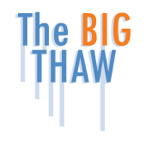
The Big Thaw: Charting a New Course for Journalism
 October 22, 2009 - What form will journalism take in the
future? Can independent media producers adapt and lead, or will they
disappear with journalism’s Ice Age?
October 22, 2009 - What form will journalism take in the
future? Can independent media producers adapt and lead, or will they
disappear with journalism’s Ice Age?
As historical business and editorial structures melt away, The Big Thaw: Charting a New Course for Journalism reveals how independent media outlets and individual media-makers can thrive. The result of a one-year study by The Media Consortium, a network of progressive media organizations, the report details the implications of market trends for journalism and business models, lays out key recommendations, and provides special tools for media-makers to strategize.
Download The Big Thaw. The report features:
- Detailed analysis of independent media’s competitive landscape and skills needed to succeed.
- Summary of market trends and their implications for journalism & business models.
- Strategy guide for media organizations.
- Leading ideas and innovations about the future of media.
- Interviews with thought leaders: John Battelle (Federated Media), John Bracken (MacArthur Foundation), Amy Gahran (Poynter Institute), Jay Harris (Mother Jones), Larry Irving, (former Assist. Secretary, U.S. Dept. of Commerce), Vivian Schiller (NPR), Clay Shirky (NYU), Ashish Soni (USC), Don Tapscott (Wikinomics), Katrin Verclas (MobileActive) and David Weinberger (Harvard) and more.
The Big Thaw’s website contains special tools for users including: a compilation of ideas for media makers on how use the report to enrich their own internal strategic planning, a list of “innovators to watch,” and daily blog posts that will highlight key areas of the report over the course of a few weeks.
The Big Thaw also lays out four broad recommendations for independent media based upon a year of research:
- Change internally: New models will most likely come from new players. The first and deepest change is to rethink how media organizations and formal networks are structured. By integrating technologists, entrepreneurs and individual media-makers, independent media will cultivate new competencies and strategies to change the journalism field.
- Increase experimentation: Greater experimentation will win. Journalism organizations must increase their capacity to innovate with new technology, journalistic practices and business models. They can do this by pursuing “rapid, low-cost innovation” and pooling their experimental efforts. Experiments will range from mobile technology (e.g. location awareness) to new forms of visual storytelling (e.g. data visualization), convergence of content across multiple platforms, filtering of information and new ways of generating revenue and reducing costs. Funders must invest in the long-term sustainability of journalism’s truth-telling by investing in greater experimentation among both new and existing players.
- Leverage unique role of a consortium: Standing together will be more valuable than working alone. Since independent media will continue to grow more diverse and fragmented, it is critical that media-makers break out of organizational silos and work together. Media outlets are finding new ways to connect and collaborate with each other to share strategies, resources and editorial content. The more that independent media-makers leverage their collective power, the more they can negotiate deals, influence public policy and build journalism’s new ecosystem.
- Building audiences as communities: The product of journalism is no longer content, but community. It is not enough to talk about community or simply enable users to comment on stories. Media organizations must create platforms for users to participate in the journalistic process, work with each other on projects and build their own online communities independent of publishers.
About The Media Consortium:
The Media Consortium is a network of over 40 leading, progressive, independent media outlets from print, radio, online, and television including Mother Jones, The Nation, AlterNet, Center for Independent Media, Link TV and more. It was formed in 2005 to amplify independent media’s voice, increase its collective clout, leverage current audiences and reach new ones, and last but not least, seize the moment to change the national debate. For the last five years, The Media Consortium has been on the front lines of the changing media landscape and is leading independent media outlets into a new era for journalism.


